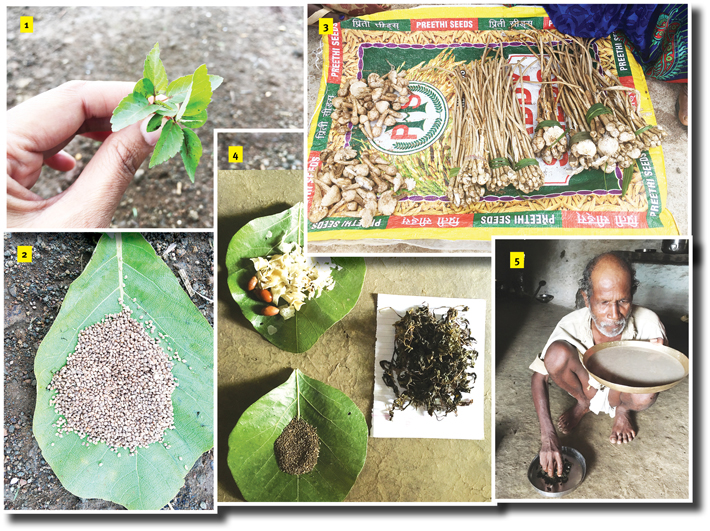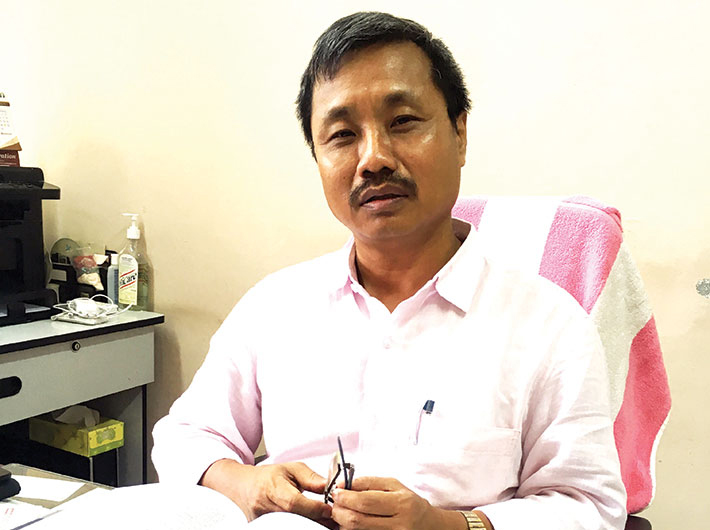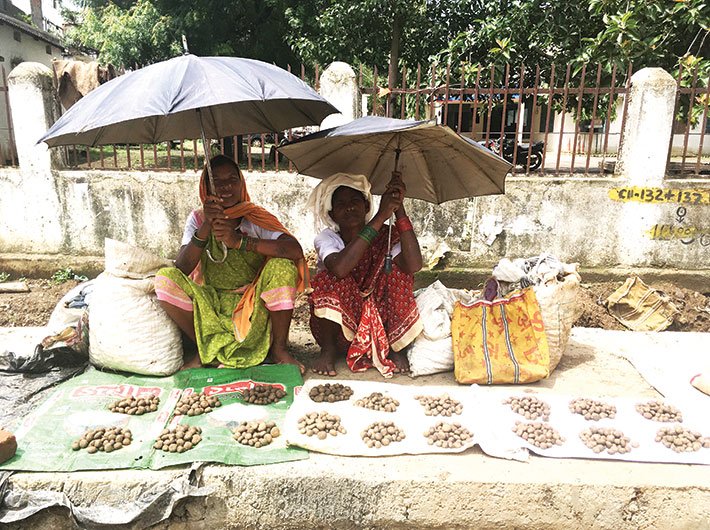The old, varied and rich diet of the Baiga tribe is being gradually forgotten – with drastic results
It’s a Friday, the day of the weekly market, or haat, in Bichhiya, on the outskirts of the Kanha tiger reserve, where the Baiga, Gond and Agariya tribals of the region congregate to sell and buy what they need. A large playground is patchworked with awnings of yellow, blue and orange plastic sheets, under which tribespeople are setting up their wares for sale: agricultural implements and utensils, silk cocoons, cured tobacco leaves, soaps, spices, eggs, chicken, ornaments.
Of course, there’s no dearth of vegetables and edible forest produce, but old-timers say a sea-change has been under way. In a corner, a woman in her sixties has for sale what looks like a handful of large, white flowers. “These are mushrooms we grow on bamboo. We eat them,” she says. “Young people hardly ever buy them. Only those who have been eating it since childhood buy them.” Another woman is selling pudpudi, greyish black mushrooms grown in mud. Again, it’s not something the young are too keen on buying.
Traditional food items of tribals are slowly disappearing from haats like this one. Kodo and kutki (millets), many varieties of leafy vegetables and roots and tubers which were an essential part of the tribal diet are now nowhere to be seen.
Studies speak of the loss of a variety of food items tribespeople like the Baiga used to obtain from the jungles. Some 30-40 years ago, there were 28 kinds of roots and tubers; only 13 kinds are available now, and only two or three kinds reach the haats. Similarly, the number of kinds of mushroom has come down from 24 to 14. And of 54 kinds of documented green, leafy vegetables that the Baiga and other tribals used to consume, only 27 are now found, mostly available only in monsoon and winter. The commonly available ones are chench (Corchorus olitorius), chakoda (Cassia tora), munga (moringa or drumsticks), kawa keni (Combretum nanum), kachnar (Bauhinia purpurea), tender leaves of amli (Bauhinia malabarica), and tender bamboo shoots.
Shyamwati, of Bhanpur Kheda village, says she goes to the forests near Sijhora to collect baichandi (a kind of tuber). “We spend nights in the forests and stay there for almost a week. It’s difficult to find baichandi now, so we don’t sell it. We consume it ourselves.”
Barring the two unusual varieties of mushroom, much of what is available at the haat is regular city fare. Millets are nowhere to be seen. The haat no longer resembles a haat for tribals, where what they have valued as traditional food items for hundreds of years is traded.
Raman, a 50-year-old Baiga, who has lived more than half his life near Kanha, says, “Everything was available to us – from meat to fish, vegetables and roots. There was no dearth of food. In a week, only one person would go to the market and get things for three to four households. Not everyone would go to the market. We used to buy only three things – bidis, tobacco and salt.”
A lifestyle change is under way. In fact, already, most village shops have popular brands of potato chips strung up – Rs 5 per packet, for not many tribal families can afford packets priced higher. Noodles, too, are available, in packets priced lower than in the cities. The big FMGC conglomerates have reached these villages. In the smaller towns in this region, roadside stalls have started selling dishes made from noodles.
If the younger folks no longer relate to traditional items, it’s largely because they have started migrating to the cities in search of jobs. Most of the men go off to big cities to work as labourers on construction sites. They start living in the cities for longer periods, only to visit their villages briefly. Food and lifestyles have changed.
As a result, a varied, nutritionally complete diet based on stuff available locally that had evolved over many hundreds of years of living the forest is dying out. Tribal vulnerability to malnutrition or chronic energy deficiency arrived with regions shifting to growing cereals, and tribals being too poor to afford grains. Now, tribals are beginning to be susecptible to hypertension, diabetes, obesity and other diseases one would associate with modern urban living.
Alarm bells
The last survey of lifestyle diseases in tribals, entitled ‘Diet and Nutritional Status of Tribal Populations and Prevalence of Hypertension in Adults’, was done by the National Nutrition Monitoring Bureau in 2009, perhaps the only such study among tribals. (See interview with its author, Dr Tapas Chakma) The report found more than 23 percent females and 20.7 percent tribal males in Madhya Pradesh suffering from hypertension. The problem of hypertension is relatively higher among older adults. In Odisha, Kerala and West Bengal 29-53 percent of tribal populations suffer from hypertension. While obesity was still negligible, 10-13 percent of tribal populations surveyed showed symptoms of diabetes.
Also, a study by a team led by Dr Yogesh Jain of the Jan Swasthya Sahayog, published in 2015, shows that particularly vulnerable tribal groups (PVTGs) like Baiga are not only undernourished but equally having hypertension and diabetes. A significant proportion of the population also suffers from tuberculosis.
The Baiga diet
Among the sayings of the Baiga, considered among the original inhabitants of Madhya Pradesh, is one that goes: ek bita jag jita, sanjh khay bihana rita. It means the stomach is a span broad, but you have to endure and conquer the whole world for its sake, and though you eat in the evening, it’s empty again in the morning, setting you off again on a quest.
For ages, the Baiga have survived on forest produce and some coarse millets like kodo and kutki. Any kind of meat is welcome -- rat, dove, fowl, crow, pig. And they consume fish too. Hunting for food was as integral a part of their lifestyle as collecting forest produce. But now, hunting is not practised as much as it was earlier. And tribals are not able to afford having meat everyday.
Says Konwariya Bai, mother of three children, “We eat chicken once a month only when any relative visits us. It’s difficult to have it even once a week.” Even fish consumption has gone down among tribal families. Earlier, they would have it almost everyday, catching them from the nearest pond on stream. Now, they have to go and get it from markets.
Charan, of Kharpariya village, went off to work in Nagpur for a living. When he’s in his village, he sometimes catches fish from a reservoir nearby. “Fishing continues for 10 months. It is a source of livelihood for many families. We sell it at Rs 50-60 kg and earn less than Rs 700 a month. Whatever we earn is spent on getting the food from the market. From pulses to rice and vegetables, everything has to be purchased from the market. Not enough money is left to buy meat every week,” he says. Families don’t eat the fish they catch.
Naresh Vishwas, who has studied the tribal culture of the region, says tribals had a smart system to breed fish and crabs. “The boundary of their agricultural land used to be at height that it could retain huge amount of rain water for the fishes to grow easily. Once they were mature they would open one side of the mud boundary and collected fish through their unique fish-catching equipment made of bamboo. Every household practised this and could avail something for themselves for one season at least. Now, with the change in the cultivation practices, this does not exist. We have made many families away from their staple food,” he says. The bamboo fish-traps are still seen in some households.
Strong gruel
It’s almost a ritual for the Baiga to have fermented gruel called pej the first thing in the morning. But from gruel made from millets, they are now turning to gruel made from rice, and even PDS wheat!
 1) Chench, a staple saag of the Baiga, eaten blanched and lightly spiced, 2) Kodo, a millet that used to be made into a gruel called pej, 3) A spread of mushrooms at the haat, 4) Chips made of baichandi root (top left), kutki (bottom left), a kind of millet, and dried chench bhaji, used in summer, 5) Patlu, an old Baiga of Bhanpur Kheda village, has a meal of wheat pej and chench bhaaji, made from the leaves in picture 1.
1) Chench, a staple saag of the Baiga, eaten blanched and lightly spiced, 2) Kodo, a millet that used to be made into a gruel called pej, 3) A spread of mushrooms at the haat, 4) Chips made of baichandi root (top left), kutki (bottom left), a kind of millet, and dried chench bhaji, used in summer, 5) Patlu, an old Baiga of Bhanpur Kheda village, has a meal of wheat pej and chench bhaaji, made from the leaves in picture 1.
Verrier Elwin, the legendary anthropologist and pioneer of Baiga studies, wrote of the mythology behind pej. “Long ago Bhagwan (God) called all the tribes of mankind to a feast. On one side he puts rice and dal, vegetable and meat curry for the Hindus. On the other side, he put chapatti, ghee and sugar for the Baiga and the Gond. When everyone had come, Bhagwan asked them to sit down and eat. But at that moment a rat came out of his hole and ran across the floor. As Bhagwan had provided no meat for the Gond and Baigas, they all jumped up and chased the rat so that they could add it to the feast. But they couldn’t catch it and when they came back they found that the Hindus had taken all their chapatti, ghee and sugar and there was nothing left for them. Bhagwan bought the water in which the rice had been boiled and gave it to them. This is pej, he said, and you will eat it forever.”
Pej is prepared by putting rice or millets in boiling water. When it is taken off the fire, cold water is added. Some keep it overnight, while others take it fresh. Sometimes roots and tubers – like kirchikanda, kanhiakanda – are also added to it. “When I was young, I’d never ever had wheat pej. It did not exist. Since we get wheat under PDS, we have started having chapatis made of wheat and drink wheat pej,” says Lamiya Bai of Kharpariya village. Millets are known to help bring down cholesterol levels. But that advantage is gradually being lost to the Baiga.
Very little farming
The forest-dwelling Baiga had tried to take to agriculture, but it was difficult. Their land holdings are minimal, they don’t have bullocks, tractors or pumps. Their farming depends on rain. Worse, soil quality is poor.
Says Shafeeq Khan, a village agriculture expansion officer for Bichhiya block, “We are trying to improve cultivation methods. Due to the poor quality of soil, the agriculture produce is less. Farmers can produce 10-15 quintals, which is approximately 15 jute bags. Generally, they sell 10 in the market and keep five for their own consumption.”
Baiga families grow paddy as they easily get seeds from agriculture department. They are gradually parting ways with the coarse grains. In 2007-08, 1,357 quintals of kodo/kutki was produced in Mandla region. It has come down to 472 quintals in 2015-16. Similarly, production of soyabean, a protein-rich legume, was 2,653 quintal in 2007-08; last year, it was 770 quintals. Some families grow mustard and maize, but it’s only for their own consumption and their produce hardly lasts them a month or two.
Sesame is no longer produced in the region. It is good for lowering cholesterol and blood pressure and rich in vitamins and minerals. Until 2007-08, 563 quintals was produced. It was reduced to 268 quintals in 2013-14. Last year, it was not grown at all.
“Variety in food is gradually coming to an end,” says Jeethu Lal, a 68-year-old tribal. “Our diet comprise of rice and wheat now. Now, we are dependent on market for our need, which was never the case. Still, to avoid extra expenditure we have sown mustard on our field. It at least helps in saving money for few months. Since land has not been allocated to us after we were thrown out of the forest, there is no source of livelihood except migration. Government has done nothing to help us.”
And the food choices they are now forced to make are robbing them, gradually, of the hardy good health of their forest-dwelling times.
Dr Tapas Chakma, Scientist G, National Institute for Research in Tribal Health, Jabalpur

‘We need a separate policy to improve tribal health’
Changes in the Baiga diet have been studied in a report that was put together by Dr Tapas Chakma of the National Institute for Research in Tribal Health, Jabalpur. In an interview with Archana Mishra, he speaks of how dietary change has affected the tribals.
As forest dwellers, the Baiga were once food-secure. How did that changed?
For generations now, their diet is cereal-based. Millets, which were an essential part of their diet, have disappeared. It is due to changes in the crop pattern, brought about in part by government policy in the last one or two decades. Exposed to urban life, the Baiga have replaced millets with paddy. Earlier, they ate food rich in micronutrients, zinc and calcium. Now, they are only eating carbohydrates in the form of rice, with poor intake of millets to control sugar levels. The public distribution system has added more carbohydrates to their diet. Because of the micronutrient deficiency and high carbohydrates, Baigas are prone to non-communicable diseases. Hypertension and diabetes have increased. Heavy consumption of alcohol and tobacco has affected them.
Is the traditional food security mechanism capable of fighting malnutrition?
Forest produce generally fulfilled the financial requirements of the Baiga; it never made them food-secure. In 28 years of my career, I have never seen them food-secure. In summers, when the vegetation dries up, their only mode of survival is pej. Sometimes, there’s just a little rice and most of it is water. So, the nutrient intake is very less. Even meat consumption is minimal. All this makes immunity low; they are easily infected. We need a separate policy to improve tribal health.
Paddy production has increased in the district. Do you still think the tribe is food insecure?
Paddy production might have increased in all these years but food insecurity has equally increased in the region. Earlier, if there was a family with two children having a land holding of five acres, they used to largely grow millet and little bit of rice. It was not grown for selling, but for their own consumption. It made them food-secure for five to six months. Now, when children grow up, the ancestral land is divided and each son gets only 2.5 acres of land. Food-security collapses with the addition of two more families. They get only half of the resources. So, the food lasts for merely three months.
Where did we go wrong?
ICDS was started in 1973 to address the problem of Grade III and Grade IV malnutrition, that is, marasmus and kwashiorkor. To improve the protein-calorie intake, the scheme initiated with anganwadi. At that time, only daliya (porridge) was given to children below six years of age. Supplementary nutrition was given to severely malnourished children. One meal of porridge can fulfill two-third of the daily protein and calorie requirement if the child is not getting meals at home. It ensured that the child would at least not fall prey to severe malnourishment. Later, this scheme was introduced in primary schools as midday meal. Today, we are giving poori and halwa to children.
archana @governancenow.com
(The article appears in the December 31, 2017 issue)

